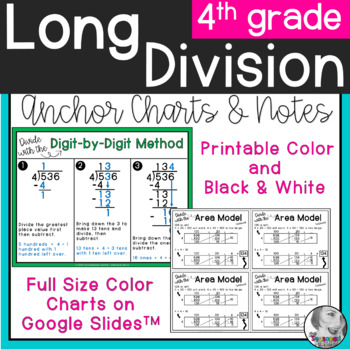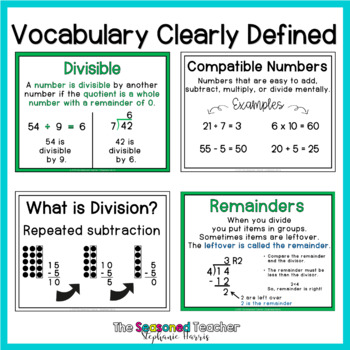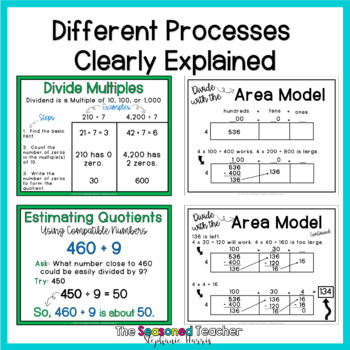4th grade Long Division Anchor Charts | Printable & Google Slides
- Zip
Also included in
- Wishing you had Math Anchor Charts for 4th grade to teach the vocabulary and math process the entire year? You are in the right place. This growing bundle of math anchor charts and notes currently includes place value, addition, subtraction, multi-digit multiplication, and long division. The 11 x 8Price $15.75Original Price $22.50Save $6.75
Description
Use these DIGITAL AND PRINTABLE math posters to teach your 4th grade Long Division unit. The 11 x 8.5 Anchor Charts in color or black and white are perfect for your Math Focus Word Wall. The Google Slides™️ are great for distance learning or sharing with parents. The quarter-page notes in color or black and white are perfect for math notebooks and games. They are Common Core Aligned. Each vocabulary word is clearly defined, and each process is shown step-by-step.
Full-Size Color Anchor Charts available on Google Slides™️.
Full-Size Anchor Charts & Quarter Page Notes are available to print in COLOR or BLACK and WHITE.
✔️ Each full-size chart (11 x 8.5) includes a matching quarter-page size anchor chart.
✔️ The quarter-page size is perfect for students to glue it in their math notebook or to use for games.
✔️ Teacher Tips on different ways to use in the classroom and on your school’s learning management system are included.
The Product Includes:
- Teacher Tips and Ideas
- Color Anchor Charts (11x8.5) PDF
- Color Quarter Page Notes for Math Notebooks PDF
- Black & White Anchor Charts (11x8.5) PDF
- Black & White Quarter Page Notes for Math Notebooks PDF
- Google Slides link to the Full-Sized Color Anchor Charts
Vocabulary and Processes Included:
- What is Division?
- Division Rule 1
- Division Rule 2
- Parts of a Division Problem
- Divisible
- Divisibility Rules for 2, 3, 5, 9, or 10
- Multiplication & Division are Inverse Operations
- Other Ways to Write Division Problems
- Division Models
- Remainders
- Divide with Remainders
- Divide Multiples (Dividend is a Multiple of 10, 100, or 1,000)
- Divide Multiples (Dividend & Divisor are Multiples of 10, 100, or 1,000)
- Place Value Sections Method
- Area Model
- Expanded Notation Method
- Traditional Algorithm
- Digit-by-Digit Method
- Does McDonald’s Sell Cheese Burgers Division Acronym
- Compatible Numbers
- Estimating Quotients
- Estimate to Check Quotient (Approach 1)
- Estimate to Check Quotient (Approach 2)
- When do I need an exact answer or an estimate?
- How to Use the Remainder (D.U.R.T.)
Click here to take a look at some of my other anchor charts.
If you have any questions, please don't hesitate to ask!
I'm just tickled you stopped by my store!
Hope you come back soon!
Stephanie Harris | The Seasoned Teacher
*************************************************************************************************************
Let's Connect!
FOLLOW ME ON My Blog - The Seasoned Teacher
FOLLOW ME ON Facebook
FOLLOW ME ON Instagram
FOLLOW ME ON Pinterest
AND
Be sure to follow my store for updates on new products and sales.






